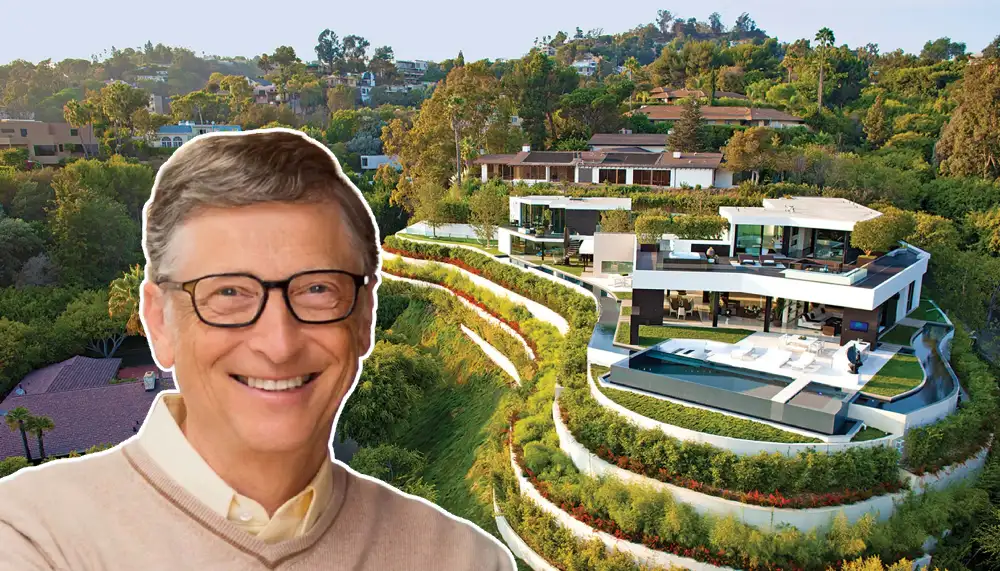The Bill Gates House, known as Xanadu 2.0, stands as a symbol of innovation and luxury in the world of billionaire residences. Located in Medina, Washington, this sprawling estate overlooks Lake Washington and blends cutting-edge technology with elegant design. Built in the 1990s, the home reflects Gates’ vision for a smart living space that anticipates the future of home automation.
With features like automated lighting, climate control, and even art displays that change on demand, it’s more than just a mansion—it’s a tech marvel. The property spans acres of lush land, offering privacy and stunning views, making it one of the most talked-about luxury homes in the United States. As the founder of Microsoft, Gates invested heavily in creating a space that combines comfort, security, and sustainability.
Today, the Bill Gates House continues to inspire discussions on high-tech homes and billionaire lifestyles, drawing interest from architecture fans and tech enthusiasts alike. Its estimated value of $183 million highlights its status as a top-tier real estate gem in the Pacific Northwest.
“He had come a long way to this blue lawn, and his dream must have seemed so close that he could hardly fail to grasp it.”
The History Behind Bill Gates House
The story of the Bill Gates House begins in the late 1980s when Gates purchased the land in Medina for around $2 million. Construction started in 1988 and took seven years to complete, finishing in 1995. The project cost over $63 million at the time, a huge sum that included advanced tech integrations unheard of in residential builds.
Gates worked with architects James Cutler and Peter Bohlin to create a Pacific Lodge-style home that fits seamlessly into the hilly landscape. Named Xanadu 2.0 after the grand estate in the movie Citizen Kane, it represents Gates’ ambition to push boundaries. Over the years, the property has seen updates, like a private tunnel added in 2006 for better access.
Even after his divorce from Melinda in 2021, Gates has kept the home as his main residence, showing his deep attachment to this iconic Medina mansion.
In the early days, the Bill Gates House was a testing ground for Microsoft technologies. Gates wanted a place where gadgets could enhance daily life without being obtrusive. This forward-thinking approach set trends for modern smart homes. Today, the estate remains a private retreat, rarely open to the public, but its details have leaked through books, interviews, and media tours.
The history also includes expansions, with Gates buying nearby parcels to increase privacy and land size. This has turned the original site into a larger compound, boosting its overall appeal as a luxury home.
Location and Surroundings of Xanadu 2.0
Nestled in Medina, Washington, the Bill Gates House enjoys a prime spot on the east shore of Lake Washington. This small town, home to other tech giants like Jeff Bezos, offers quiet streets and high-end living just minutes from Seattle. The address, 1835 73rd Ave NE, provides stunning water views and easy access to nature trails.
The surrounding area features evergreen forests, upscale neighborhoods, and strict zoning laws that keep the community exclusive. Gates’ property includes 475 feet of waterfront, perfect for boating or relaxing by the lake.The location adds to the allure of this Lake Washington estate. Medina’s low crime rate and top schools make it ideal for families, though Gates now lives there as an empty nester.
Proximity to Microsoft headquarters in Redmond was a key factor in choosing the site. Visitors can’t tour the home, but satellite images and public records give glimpses of the expansive grounds. The surroundings emphasize privacy, with tall trees and security measures shielding the billionaire mansion from prying eyes.
This setting blends urban convenience with natural beauty, making Xanadu 2.0 a standout in Washington real estate.
“My house in Seattle, I admit, is gigantic. My sisters have downsized. I can’t. I like the houses I have.”
Architectural Design and Size of the Medina Mansion
The architecture of Xanadu 2.0 draws from Pacific Northwest styles, using wood, stone, and glass to blend with the environment. The main structure is earth-sheltered, built into a hillside for energy efficiency and a low profile. Spanning 66,000 square feet, the home includes multiple wings connected by hallways. The design focuses on open spaces, with large windows letting in natural light and offering panoramic views of Lake Washington.
Key elements include a domed library and a reception hall that can host 200 guests. The exterior features recycled wood beams and local stone, giving it a rustic yet modern feel. Inside, the layout supports both family life and entertaining, with separate areas for work and relaxation. The size allows for diverse rooms, from a trampoline gym to a home theater. This thoughtful design makes the Bill Gates residence not just big, but functional and inviting.
High-Tech Features in Bill Gates House
What sets the Bill Gates House apart is its array of high-tech features. Guests receive pins upon arrival that track their preferences for lighting, temperature, and music, adjusting rooms automatically. The home runs on a custom server system, controlling everything from security cameras to entertainment. Walls have hidden speakers and screens that display digital art or family photos on command.
Other innovations include a sensor-based heating system and automated shades. The pool has an underwater sound system, letting swimmers enjoy music below the surface. Gates’ love for tech shines in the private server room, which powers the entire estate. These elements make Xanadu 2.0 a pioneer in smart home technology, influencing today’s devices like smart thermostats and voice assistants. Security is top-notch, with motion detectors and a private tunnel entrance.
Luxury Amenities and Interiors of the Billionaire Residence
Luxury defines the interiors of this high-tech home. With 24 bathrooms and six kitchens, the estate can handle large gatherings effortlessly. The master suite offers lake views, while guest rooms provide hotel-like comfort. A 2,500-square-foot gym includes a sauna and steam room for wellness. The trampoline room adds fun, especially for kids.
The library houses rare books, including Leonardo da Vinci’s Codex Leicester, bought by Gates for $30 million. Art pieces rotate on digital displays, keeping the space fresh. The dining room seats 24, with a grand table for formal meals. Kitchens feature pro-grade appliances, and there’s even a pizza room. These amenities turn the Medina mansion into a self-contained paradise, blending opulence with practicality.
Sustainability and Eco-Friendly Aspects
Sustainability plays a big role in Xanadu 2.0. The home uses geothermal heating and cooling, pulling energy from the earth to reduce power use. Rainwater collection systems irrigate the grounds, and heat recovery ventilation keeps air fresh without waste. Solar panels help offset electricity needs, aligning with Gates’ environmental focus.
The design minimizes impact on the local ecosystem, with native plants in the landscaping. Energy-efficient windows and insulation cut down on heating costs. Gates has spoken about climate change, and his home reflects that commitment. These green features make the luxury home a model for eco-friendly billionaire residences, proving that high-end living can be kind to the planet.
The Value and Property Details of Bill Gates House
The Bill Gates House holds an assessed value of around $183 million for the entire compound, including surrounding parcels. Annual property taxes exceed $1 million, reflecting its prime location and size. Market estimates vary, but the investment has grown since the original build cost. Gates owns it through a management company for privacy.
This value includes the land, buildings, and tech upgrades. Compared to other celebrity homes, it stands out for its innovation rather than sheer flash. The property’s worth continues to rise with Seattle’s real estate market, making it a smart asset in Gates’ portfolio.
“Bill Gates’ Medina home is so big and so famous that it has its own Wikipedia page.”
Bill Gates’ Other Properties Around the World
Beyond Xanadu 2.0, Gates owns a diverse real estate collection. In California, he has a ranch in Santa Fe and a home in Indian Wells. Florida properties include a horse farm in Wellington for his daughter. He also invests in farmland across the U.S., focusing on sustainable agriculture.
These holdings show Gates’ interest in varied lifestyles, from coastal retreats to rural lands. While the Medina residence remains his primary home, these others provide escapes and investment opportunities. His portfolio emphasizes quality and purpose over quantity.
FAQs About Bill Gates House
What is the size of Bill Gates House?
The Bill Gates House, or Xanadu 2.0, covers 66,000 square feet of living space. This includes multiple rooms, wings, and amenities like a gym and theater. The property sits on over five acres, with additional land from nearby parcels, offering plenty of room for privacy and outdoor activities in Medina, Washington.
Where is Bill Gates House located?
Bill Gates House is in Medina, Washington, at 1835 73rd Ave NE. This quiet suburb near Seattle overlooks Lake Washington, providing beautiful water views and easy access to the city. The location is known for its upscale homes and famous residents, making it a secure and scenic spot for the billionaire.
What is the value of Bill Gates House?
The assessed value of Bill Gates House and its surrounding compound is about $183 million as of recent records. This figure accounts for the land, buildings, and high-tech features. Property taxes run over $1 million yearly, and the market value could be higher due to its unique design and prime location.
What high-tech features does Xanadu 2.0 have?
Xanadu 2.0 boasts advanced tech like automated climate control, digital art walls, and a sensor system that adjusts lighting and music based on guest preferences. It also has an underwater sound system in the pool and a full home server. These features make it a leader in smart home innovation.
Why is it called Xanadu 2.0?
The name Xanadu 2.0 comes from the fictional estate in the movie Citizen Kane, symbolizing grand ambition. Bill Gates chose it to reflect the home’s futuristic vibe. The “2.0” nods to tech upgrades, fitting for a Microsoft founder. It highlights the property’s blend of luxury and cutting-edge design.




No Comment! Be the first one.